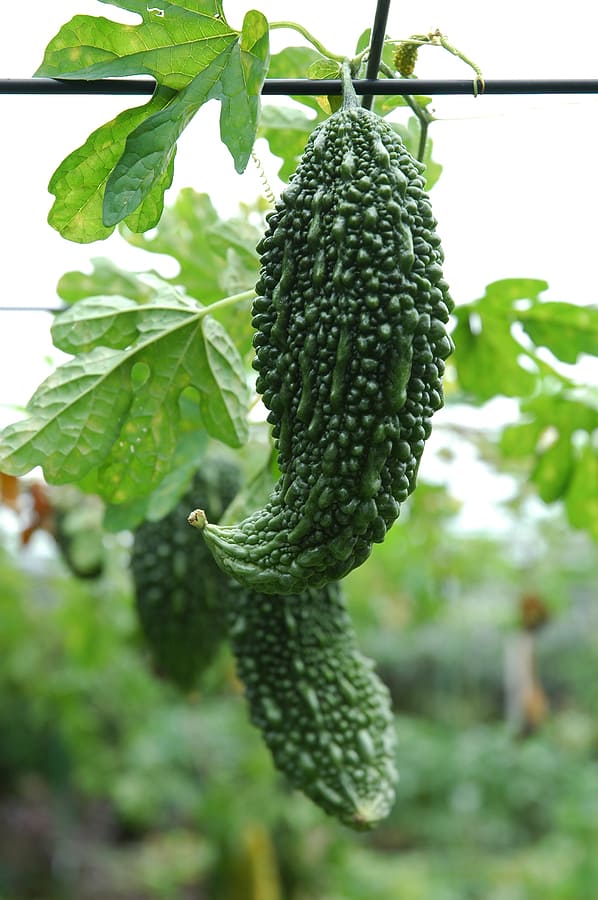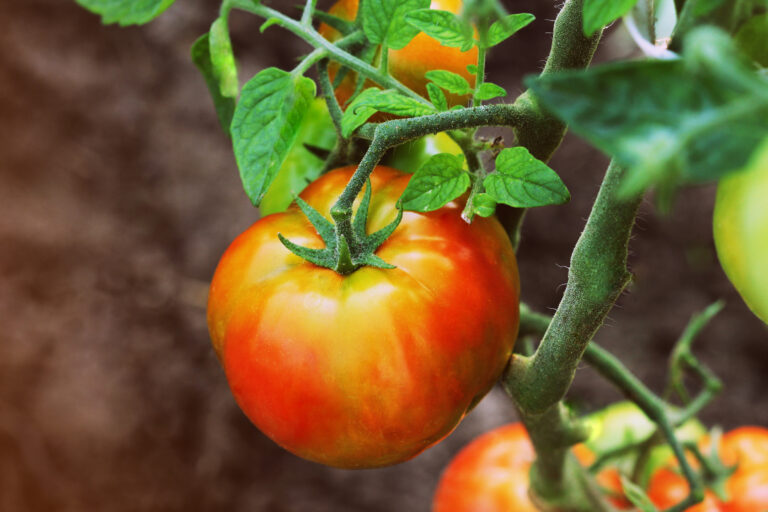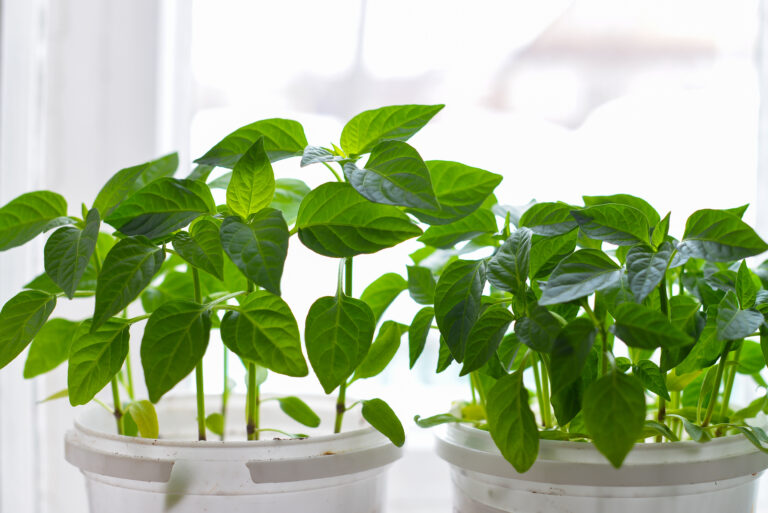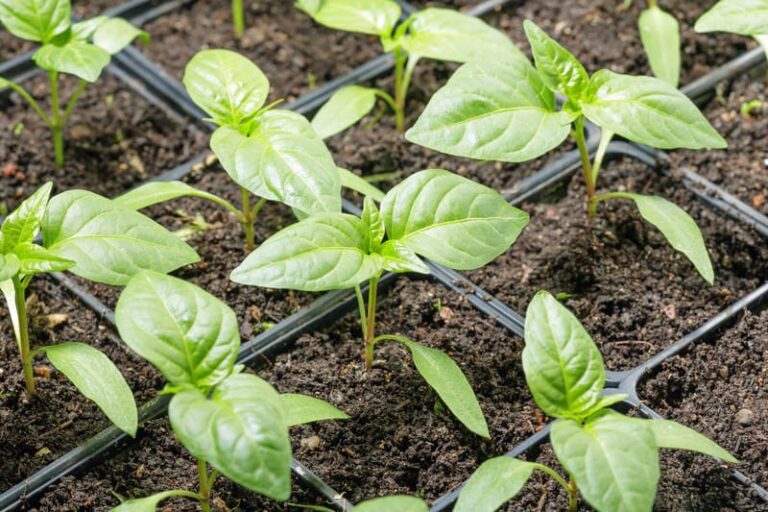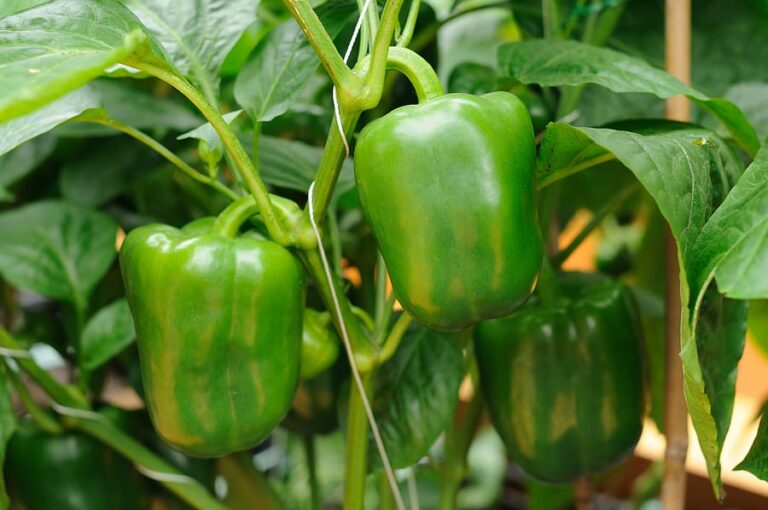Growing Bitter Melon: From Planting to Harvest
Bitter melon is a favorite in Asian and Southeast Asian cooking. It can be stuffed with pork or shrimp and steamed or pickled or curried and served with meat or in soup.
Bitter melons are—as their name suggests–a bitter and mouth-puckering acquired taste—something like the acquired taste of a grapefruit or very dark chocolate.
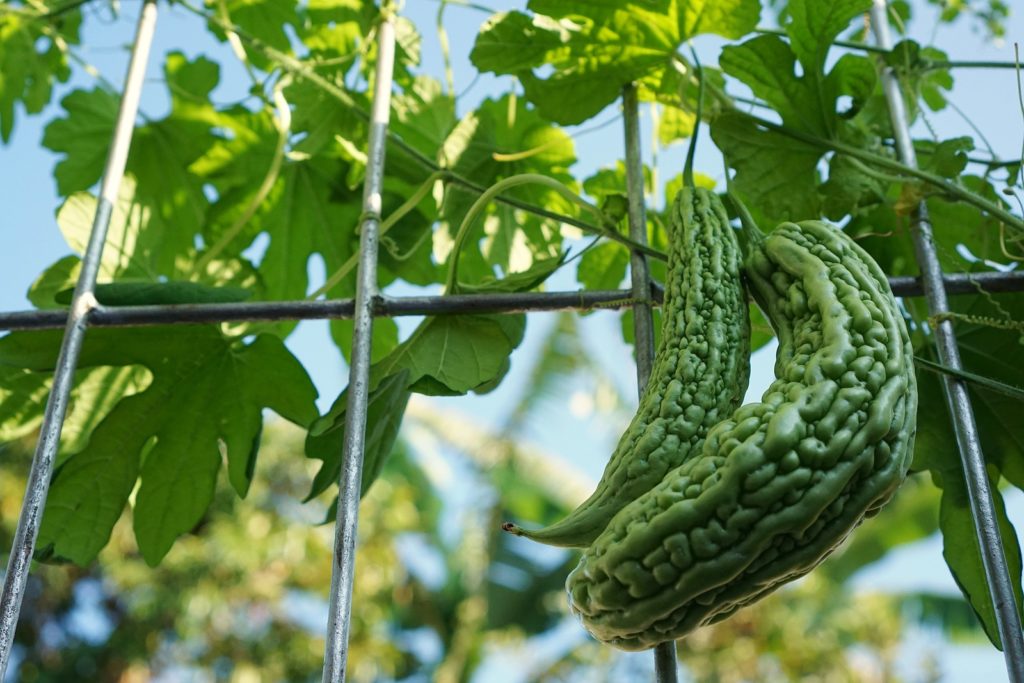
The bitter melon is a member of the Cucurbitaceae family, which includes squash, watermelon, muskmelon, and cucumbers. Bitter melon can be grown much like cucumbers or cantaloupes but they are a subtropical plant and require at least three to four months of warm to hot and humid weather to mature.
Good Products for Pest and Disease Control at Amazon:
- Garden Safe Snail and Slug Bait
- Bonide Sulfur Fungicide
- Monterey BT Caterpillar Killer
- Neem Bliss 100-% Cold Pressed Neem Oil
- Safer Brand Insect Killing Soap
- PyGanic Botanical Insecticide
Bitter melon is a vining plant. It has deeply lobed leaves and grows in a fashion similar to squash, cucumbers, and watermelon producing vines 13 to 16 feet long if left unpruned. Fruits are oblong and either smooth or warty, usually about 8 inches (20 cm) long but fruits can vary in length between 2 and 10 inches (5-25 cm) long. The fruit shifts in color from green to yellow to orange as it ripens and over-ripens. The flesh has a watery, crunchy texture, similar to a cucumber.
Yield: Each plant will produce 10 to 12 fruits and perhaps a few more.
When to plant bitter melon
Bitter melons are a warm-season crop and are best suited for growing in tropical and subtropical heat and humidity. Grow bitter melons where daytime temperatures average between 75 and 80°F (24-31°C). Plant bitter melons in late spring or early summer. Sow seed outdoors or set out transplants no sooner than two to three weeks after all danger of frost has passed and the soil has warmed to at least 60 to 65°F (15-18°C).
Where to plant bitter melon
Bitter melons grow best in hot and humid climates. Choose a warm, sunny location—at least 6 hours each day–to plant. Plant bitter melons in compost-rich, well-drained soil with a pH ranging from 5.5 to 6.7. Prepare growing beds in advance of planting by adding aged compost and aged manure. Bitter melons can tolerate less desirable sandy- or siltly-loam soil but good drainage is essential.

Planting and spacing bitter melon
Sow seeds in holes about half-inch deep (1.25 cm) and spaced 12 inches (30 cm) apart. Sow two seeds in each hole. Seeds germinate in 8 to 10 days, though low and high temperatures and soil too dry or too wet can slow germination. Vigorous plants trained on a trellis or fence can be spaced 9 to 10 feet (2.7-3 meters) apart. Plants allowed to sprawl on the ground should be grown on straw or plastic mulch to prevent fruits from resting on moist soil where they might rot.
Trellising bitter melon
Trellising can reduce diseases and make harvesting easier. Place a trellis 6 feet (1.8 meters) high and wide or slightly more next to each plant. When the vine grows to the top of its trellis, prune or pinch away all lateral branches from the soil up to the 10th node. This will stimulate the upper branches to grow and produce a higher yield. Prune laterals from 2 to 3 feet long (.6-.9 meters) and prune away the growing tip when it reaches the top of the trellis. As a result, the plant will produce a greater number of flowers and fruit sooner.
Fruit grown from a trellis will grow longer and straighter than those grown on the ground.
Watering and feeding bitter melon
Keep bitter melon planting beds evenly moist; regular water is essential for fruit development and growth. Aged compost will feed melon plants. You can also add a slow-release organic fertilizer such as 5-10-10 around plants early in the season. Side-dress plants with aged compost during the growing season to add nutrients and to help retain moisture in the soil. To give plants a boost water with compost or comfrey tea every third week during the growing season.
Bitter melon companion plants
Plant bitter melon with beans, corn, peas, pumpkins, and squash. Do not grow bitter melons with potatoes and herbs.
Bitter melon care
Trellised vines produce hanging fruit, which grows long and straight. Vines allowed to sprawl on the ground should be mulched with straw or plastic to keep fruit from resting on the soil.
The growing tips of trellised vines should be pruned or pinched when they reach the top of the support, as should long lower lateral branches. This will concentrate the plant’s energy and result in more flowers and fruit. Prune when the first female flowers appear; female flowers follow male flowers.
Bitter melon pollination
Vines commonly begin flowering about 5 to 6 weeks after planting. Male flowers open first, followed in a week or so by female blossoms. Both flowers are yellow. Female flowers have a swelling (the ovary) at the base of the bloom resembling a tiny melon. Bees and pollinating insects visit both blooms, transferring pollen from male to female flowers. Usually, male blooms live only one day; they open in the morning and fall from the plant in the evening. Flower drop is not uncommon.
The ovary of pollinated female flowers will begin to enlarge and fruit will mature in two to four months. Mature fruits will be ready to pick about 12 weeks after planting. They will be light green and juicy with white, bitter flesh.
Hand-pollinating bitter melon
Bitter Melons are pollinated by insects and honeybees. If there are flowers but no fruit forms and you find no bees at work in the garden, then you may rightfully suspect that pollination has not occurred. Pollination can be done by hand—this is true for cucumbers and squash as well: pick male flowers and transfer pollen by touching the center part of the male flowers against the center of the female flowers. (Female flowers have an enlarged section that looks like a little fruit between the flower and the vine stem; males don’t.)
Container growing bitter melon
Bitter melon can be grown in a pot. Choose a container that can hold at least 5 gallons (19 liters) of potting soil—more is better. Make sure the container drains well.
Bitter melon pests
Bitter melon can be attacked by spotted and striped cucumber beetles. Cucumber beetles can carry bacterial wilt disease which will cause vines to collapse. Infected vines don’t recover. Spray adult beetles with rotenone or a pyrethrum-based insecticide. Use all pesticides at dusk to avoid harming honey bees.
Fruit flies may also attack bitter melons; they can spread fruit rot. Prevent flies from reaching the fruit by covering fruits with paper bags secured with twine or rubber bands or wrapping them with newspaper when the fruits are just an inch or two long.
Keep the garden free of weeds; weeds often harbor pest insects.
Bitter melon diseases
Bitter melon is susceptible to most of the same diseases that plague squash and cucumbers: fungal diseases such as powdery mildew, downy mildew, and rust and rots as well as watermelon mosaic virus and bacterial wilts. Trellising which increases air circulation around vines can help reduce fungal diseases. For non-trellised vines, use a straw or plastic mulch to keep melons from resting directly on moist soil. There is no cure for plants attacked by viruses. When possible, plant disease-resistant varieties.
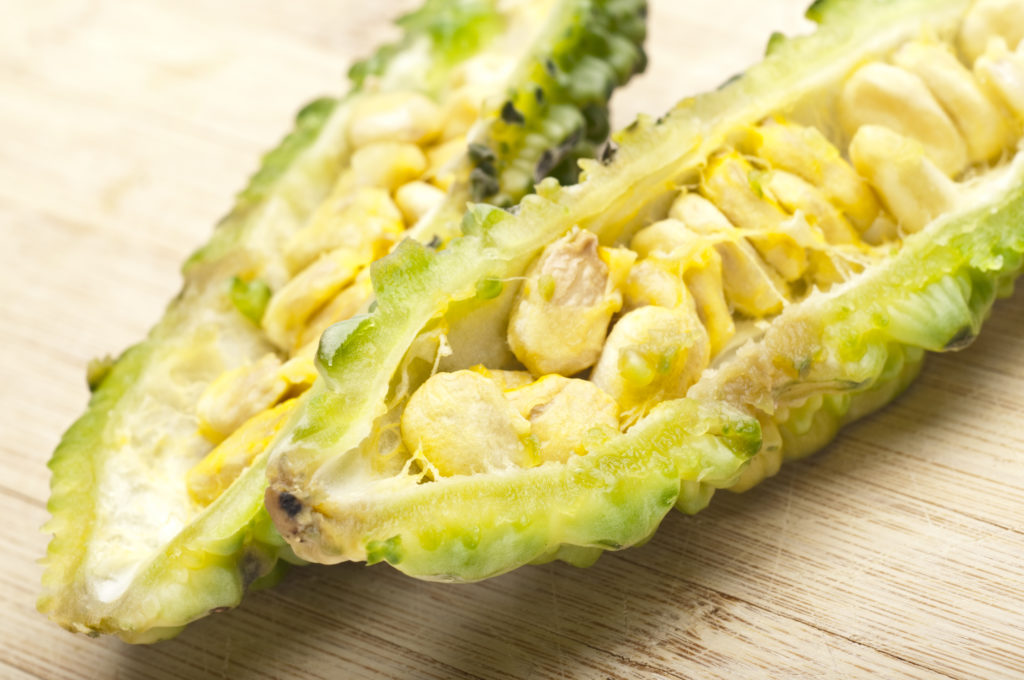
Harvesting bitter melon
Harvest bitter melon about 12 to 16 weeks after planting and 8 to 10 days after blossom drop when the fruits are 4 to 6 inches (10-15 cm) long. The fruits will be a bit pear-shaped, with light green skin and a few streaks of yellow. If fruits stay too long on the vine they will over-ripen, turn all yellow, grow too large, and become bitter. Fruits on the same vine can vary in their degrees of bitterness—melons both immature and overripe can taste very bitter.
The bitter melon has a thin layer of flesh that turns orange to bright red when ripe. The flesh surrounds a hollow interior cavity with spongy, white pulp peppered with seeds. The fruit will be watery and crunchy much like a cucumber.
Bitterness is the result of the alkaloid momordicine found in growing bitter melons; the darker the color of a bitter melon the more bitter and intense the flavor of the fruit.
Once melons start to ripen, pick fruits regularly every two to three days. The more you pick, the more fruits will form.
Bitter melon seed production
To save seed for next season, leave a few fruits on each vine to mature past harvest. Mature fruits will break open and release brown or white seeds. Collect the seed, sort it, wash it, and dry it on a countertop, then store it in a cool, dry spot. It will remain viable for 2 to 3 years.
Bitter melon varieties to grow
Bitter melons native to India have a narrow surface with pointed ends and are covered with triangular “teeth” and ridges. Bitter melons native to China are oblong with blunt ends and have a gently undulating, warty surface.
Chinese varieties include Large Top, Hong Kong Green, China Pearl, Southern Money Maker, and Hybrid White Pearl.
Indian varieties include India Long Green, India Long White, Hybrid India Green Queen, and Hybrid India Pearl.
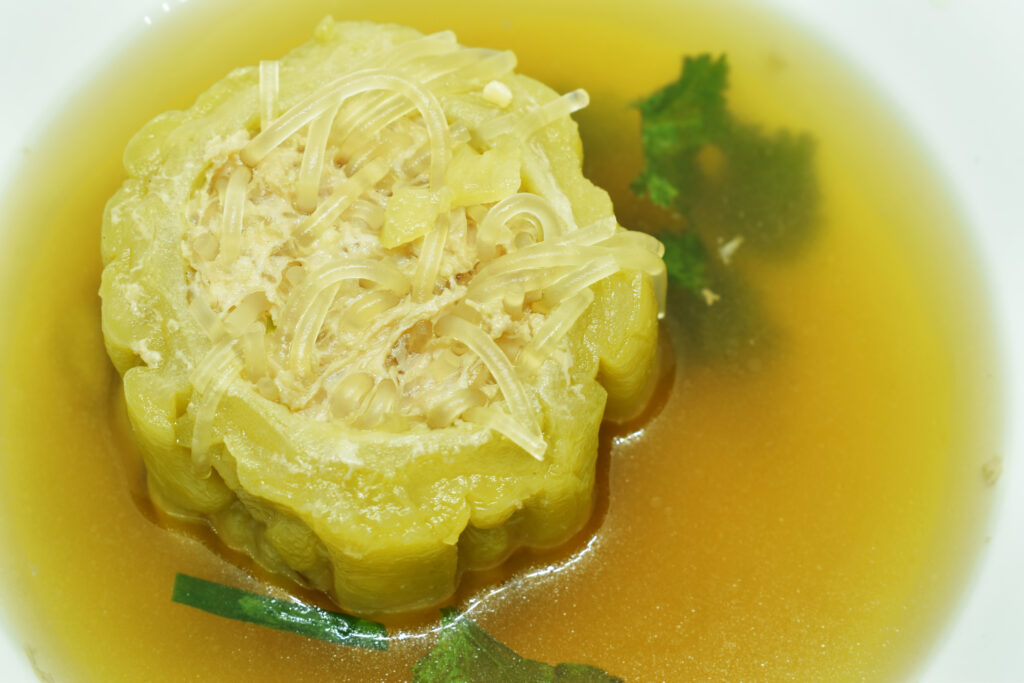
Bitter melon kitchen use
To prepare bitter melon, slice the fruit open and remove the seeds and pith. Do not peel. The fruit can be parboiled or soaked in salted water to lessen bitterness however this can affect the fruit’s normally crunchy texture.
Bitter melon can be stuffed (often stuffed with pork or shrimp and steamed), pickled, or curried and served with meat or in soup. The fruit pairs well with other strong flavors, like garlic, Chinese black beans, chili peppers, or coconut milk.
A dietary note: bitter melon is used in traditional Chinese medicine and in alternative medicine to treat Type 2 diabetes. It is also a folk remedy for treating high blood pressure. The combination of bitter melon and drugs sometimes used to treat hyperglycemia can decrease blood sugar levels to dangerously low levels.
Bitter melon has twice the beta carotene of broccoli, twice the potassium of bananas, and twice the calcium of spinach. It also contains high amounts of fiber, phosphorous, and Vitamins C, B1, B2, and B3.
Storing and preserving bitter melon
Store bitter melons in a paper or plastic bag in the refrigerator between 53-55° F. (11-12°C.). Use within 3 to 5 days of harvest. Store bitter melon fruit away from other ripening fruits to avoid hastening the ripening process.
Get to know bitter melon
Common name: Bitter gourd, balsam pear, karela, bitter cucumber, bitter squash, African cucumber, alligator pear, ampalaya, goya.
Botanical name: Momordica charantia
Origin: Southern China and eastern India
More growing articles:
Best Herbs for Container Growing
Garden Planning Books at Amazon:

